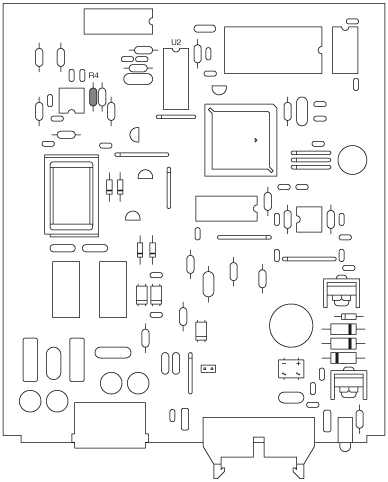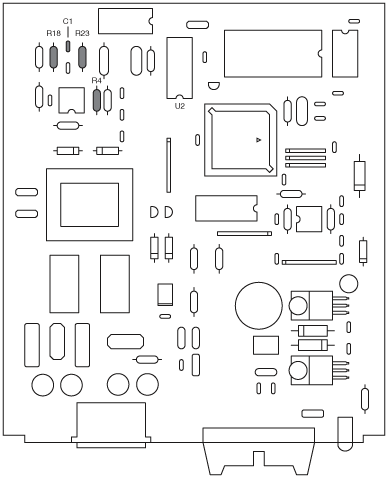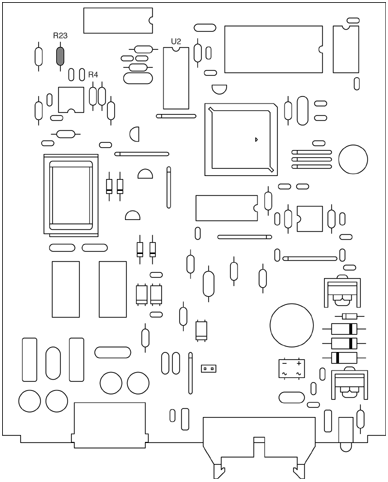Engineering Bulletin
Improving RFC-1/B Tone Reception
Intended Audience
The modifications described in this document are easy for someone who is technically knowledgeable and proficient at soldering and de-soldering. If you do not fit this category then you should contact someone who is more suited to the task.
Description
The procedure described in this document typically improves DTMF (Touch-Tone) detection in the RFC-1/B. It applies to systems that work normally when accessed from the "local phone" that is connected directly to the system but work intermittently or fail when dialing in from a remote location.
Background
The tone detection IC in the RFC-1/B has no interface for microprocessor control. There are no software adjustments in the RFC-1/B to adjust the tone detector. The following modifications increase the incoming signal to compensate for weak signals.
Transmitter sites are often located in remote areas where landlines are prohibitively expensive. It has become common to connect the RFC-1/B to devices that emulate a landline while connecting to a cellular phone network.
Experience shows that cellular service is not very good at passing strong, clean DTMF tones. The worst case is to use a cell phone to call an RFC-1/B that is connected to a line emulation device. These devices are wonderfully convenient but they attenuate the DTMF tones and make it difficult for the RFC-1 to work effectively.
Procedure
The information in this section of the document applies to all RFC-1/B board revisions. Boards will have an IC at position U2 with any of the following part numbers: HT9170B, CD22202, CD22204, 75T202 or 75T203.
Board Removal
If you have not already done so, unplug the ribbon cable to the RFC-1/B control unit. There are no changes to the RP-8 in this modification so cables to the RP-8 can be left in place.
Remove the RFC-1/B from the rack if necessary. Remove the two screws from the rear panel. Remove the rear panel and plastic bezel from the RFC-1/B. Slide the RFC-1/B circuit board from the chassis.
Inspection
Resistor R4 should be located near the upper left corner of the RFC-1 circuit board. It is shaded in the image below. Resistor R4 should be next to the 8-pin IC in all cases. If it is not, do not make any changes.

Location of R4 on all RFC-1/B board revisions
First Adjustment
The modification is a resistor substitution that involves only R4. Most RFC-1/B systems have a 20K ohm 1% tolerance resistor at position R4. Replace this resistor with a 27K ohm, 1% tolerance, 1/4 watt resistor.
The modification is complete. Test the system.
Second Adjustment
If the modification fails to solve the problem then substitute a slightly larger value resistor, 33K ohms. If that does not work, try 39K ohms.
It is important to be conservative when changing the value of resistor R4. This procedure should solve tone detection problems on remote calls but also may potentially cause tone detection problems on the local phone if adjusted too much.
Early Board Revisions
This modification applies only to RFC-1/B board revisions with an IC at position U2 that is labeled: CD22202, CD22204, 75T202 or 75T203. These board revisions will have R23 located where shown in the drawing below. This procedure should only be performed on the specified board revisions.
Board Removal
Unplug the ribbon cable to the RFC-1/B control unit. There are no changes to the RP-8 in this modification so cables to the RP-8 can be left in place.
Remove the RFC-1/B from the rack if necessary. Remove the two screws from the rear panel. Remove the rear panel and plastic bezel from the RFC-1/B. Slide the RFC-1/B circuit board from the chassis.
Inspection
The board should look like the image below. Look carefully! Performing an incorrect modification will make the problem worse.
The IC at location U2 must be labeled CD22202, CD22204, 75T202 or 75T203. Do not perform this procedure if there is another IC at position U2.
Resistor R23 should be located near the upper left corner of the RFC-1 circuit board. It is shaded in the image below. If R23 is not in the same location as shown in this image then this modification is not appropriate for your system.

Location of R23 on early RFC-1/B board revisions
First Adjustment
The modification is a resistor substitution that involves only R23. Most RFC-1/B systems have a 270K ohm resistor at position R23. Replace this resistor with a 100K ohm, 5-10% tolerance, 1/4 watt resistor.
The modification is complete. Test the system.
If the modification fails to solve the problem then substitute a smaller value resistor, about 47K ohms. If that does not work, try 10K ohms.
Second Adjustment
This modification involves R18 in addition to R23. R18 is located to the left of R23 across the two small capacitors. As before, if the location of the parts does not match the drawings then do not continue with this procedure.
Remove both R23 and R18 from the circuit. Do not replace R18 will anything and do not short it. Replace R23 with a low value resistor anywhere from 1K down to 100 ohms. If a suitable resistor is not available R23 can be shorted.
If you are in the field and do not have a low value resistor available, use the resistor removed from R18. At 33K ohms the value is a little high but with R18 removed from the circuit the value of R23 is less critical.
The modification is complete. Test the system.
If the system works from the local phone but does not work when dialed in, there is another modification. Locate a very small capacitor C1 between R23 and R18 in the drawing above. If it exists in the same location on your board, carefully remove it from the circuit.
The modification is complete. Test the system.
If these modifications are made correctly and the system does not detect tones when dialed in then the tones are at a very low level or something else wrong. If the RFC-1/B works using the local phone then the tone detector is functioning.
Late Board Revisions
This modification applies only to RFC-1/B board revisions with an IC at position U2 that is labeled HT9170B. These board revisions will have R23 located where shown in the drawing below. This procedure should only be performed on the specified board revisions.
This is the modification of last resort. Do not perform this modification until all other options are exhausted. It has the potential to distort the signal so that the tones from the local phone fail. That condition is most undesirable.
Resistor R23 should be located near the upper left corner of the RFC-1 circuit board. It is shaded in the image below. If R23 is not in the same location as shown in this image then this modification is not appropriate for your system.

Location of R23 on late RFC-1/B board revisions
The modification is a resistor substitution that involves only R23. RFC-1/B systems have a 100K ohm resistor at position R23. Replace this resistor with a slightly lower value 1/4 watt resistor with 1-5% tolerance. The value is not critical but it should be around 82K ohms or 75K ohms. Be conservative.
The modification is complete. Test the system.
If the modification fails to solve the problem then substitute a slightly lower value resistor, 62K ohms. If that does not work, try 51K ohms or 47K ohms. Do not use a resistor lower than 47K ohms!
It is important to be conservative when changing the value of resistor R23. Use the largest value resistor that works. Test both local and remote operation. This procedure should solve tone detection problems on remote calls but also may potentially cause tone detection problems on the local phone if adjusted too much.
